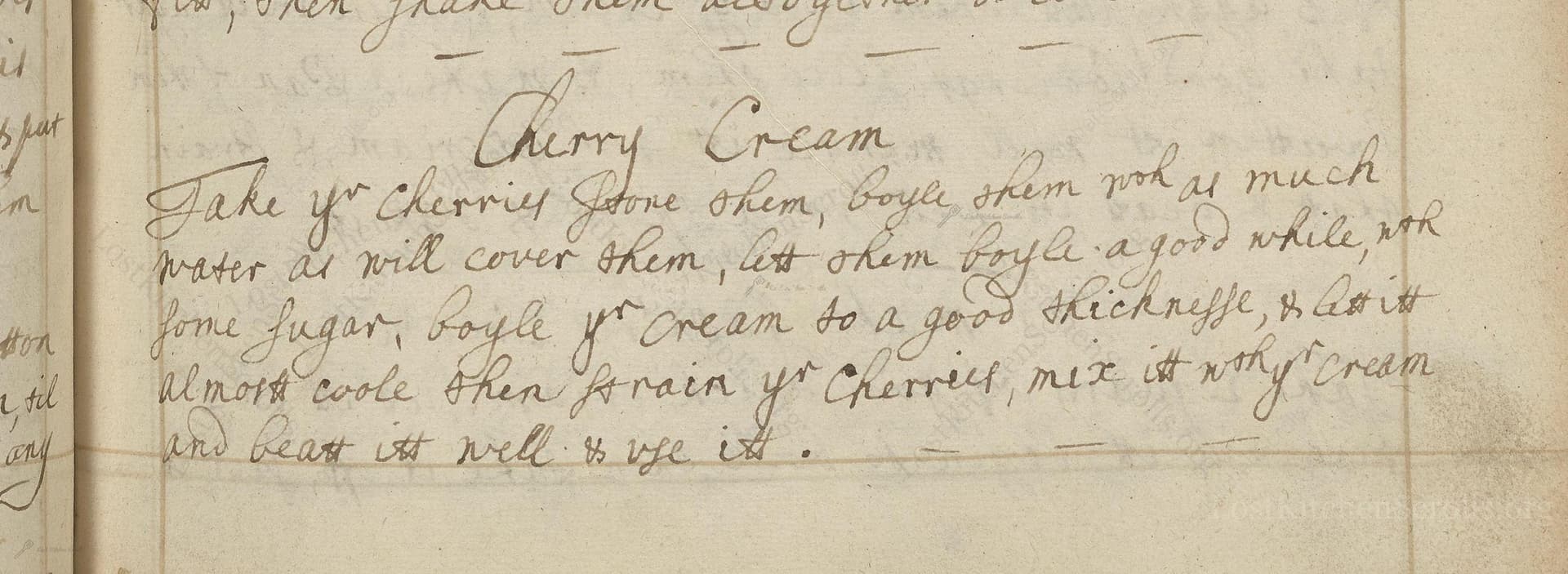Cherry Cream
From the treasured pages of Receipt book of Mary Hookes
Written by Mary Hookes

Cherry Cream
"Take yr Cherries stone them, boyle them with as much watter as will cover them, lett them boyle a good while, with some sugar, boyle yr Cream to a good thicknesse, & lett itt almost coole then strain yr Cherries, mix itt with ye Cream and beatt itt well & use itt."
Note on the Original Text
The recipe is written in an early modern English style, characterized by abbreviated words (e.g., 'yr' for 'your', 'itt' for 'it') and a lack of precise measurements or timing. Directions are descriptive, relying on a cook’s intuition and existing knowledge. Spelling often varies (e.g., 'boyle', 'thicknesse') as standardized spelling had not yet taken hold. The focus is on method rather than quantities, which was typical for household recipe books of the late 17th and early 18th centuries.

Title
Receipt book of Mary Hookes (1700)
You can also click the book image above to peruse the original tome
Writer
Mary Hookes
Era
1700
Publisher
Unknown
Background
A delightful voyage into the kitchens of the late 17th and early 18th centuries, this book teems with forgotten flavors, aromatic recipes, and the elegant wisdom of early modern cookery. A treasure trove for culinary adventurers craving a taste of the past!
Kindly made available by
Folger Shakespeare Library
This recipe comes from the manuscript collection of Mary Hookes, who was active around 1675 to 1725 in England. It reflects the 17th-century English tradition of combining seasonal fruit with dairy to create comforting and elegant dishes for the table. Recipes like this were often found in household manuscripts, written by or for women who managed kitchens and preserved culinary knowledge. At the time, using seasonal cherries in cream would have been a luxurious but accessible treat for those with orchards, reflecting both the local bounty and the evolving art of English dessert-making.

Back in the day, this recipe would have been prepared over a hearth or in a kitchen with a wood- or coal-fired range. Cherries would be stoned by hand, likely using a simple knife. The boiling would take place in heavy-bottomed pans or earthenware pots. Cream would be thickened in a smaller pan over gentle heat, constantly stirred with a wooden spoon. After boiling, the mixture would be strained through cloth or a fine sieve, and mixed in a large bowl using a wooden spoon or whisk. Serving would be done in china bowls or glasses if available.
Prep Time
10 mins
Cook Time
30 mins
Servings
4
We've done our best to adapt this historical recipe for modern kitchens, but some details may still need refinement. We warmly welcome feedback from fellow cooks and culinary historians — your insights support the entire community!
Ingredients
- 18 ounces fresh cherries (sour or sweet)
- 1 1/4 to 1 2/3 cups water
- 1/3 cup granulated sugar (or more to taste)
- 2 cups double cream (substitute: heavy cream)
Instructions
- Begin by pitting about 18 ounces of fresh cherries.
- Place them in a saucepan and add enough water to just cover the cherries, around 1 1/4 to 1 2/3 cups.
- Add 1/3 cup of sugar (or to taste).
- Bring to a gentle boil and let them simmer for 15-20 minutes until the cherries are softened and the liquid is richly flavored.
- In a separate pot, heat 2 cups of double cream (or heavy cream) to a simmer and gently reduce until it thickens slightly, stirring to prevent scorching.
- Remove the cream from the heat and allow it to cool until just warm.
- Strain the simmered cherries to remove the solids, reserving the vividly colored cherry syrup.
- Blend the syrup with the cooled thick cream and whisk thoroughly until well combined and velvety.
- Chill if desired and serve, either as a poured cream or as a dessert sauce.
Estimated Calories
265 per serving
Cooking Estimates
It takes about 10 minutes to prepare the ingredients, like pitting the cherries. The cooking takes 30 minutes, which includes simmering the cherries and thickening the cream. Each serving has about 265 calories, and the recipe makes 4 servings.
As noted above, we have made our best effort to translate and adapt this historical recipe for modern kitchens, taking into account ingredients nowadays, cooking techniques, measurements, and so on. However, historical recipes often contain assumptions that require interpretation.
We'd love for anyone to help improve these adaptations. Community contributions are highly welcome. If you have suggestions, corrections, or cooking tips based on your experience with this recipe, please share them below.
Join the Discussion
Rate This Recipe
Dietary Preference
Culinary Technique

Den Bockfisch In Einer Fleisch Suppen Zu Kochen
This recipe hails from a German manuscript cookbook compiled in 1696, a time whe...

Die Grieß Nudlen Zumachen
This recipe comes from a rather mysterious manuscript cookbook, penned anonymous...

Ein Boudain
This recipe comes from an anonymous German-language manuscript cookbook from 169...

Ein Gesaltzen Citroni
This recipe, dating from 1696, comes from an extensive anonymous German cookbook...
Browse our complete collection of time-honored recipes



